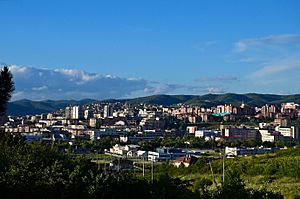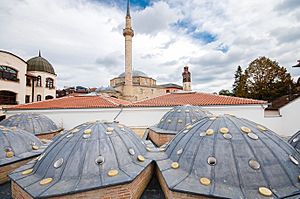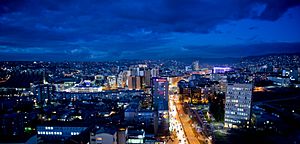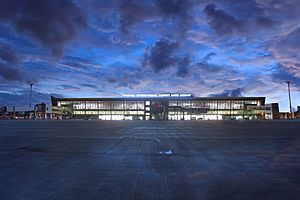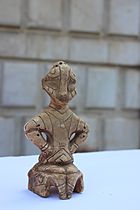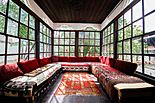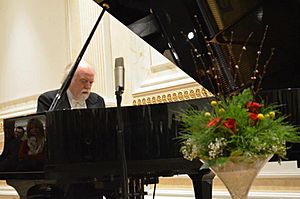Pristina facts for kids
Quick facts for kids
Pristina
Prishtina
|
|||
|---|---|---|---|
|
City
|
|||
| City of Pristina | |||
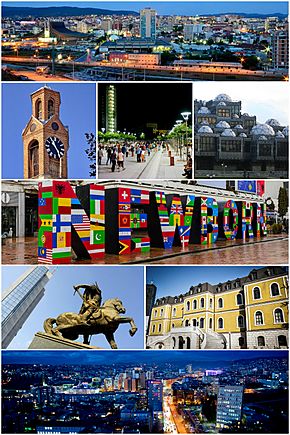
Clockwise from top: Panorama of Pristina, Clock Tower, Skanderbeg Square, National Library, Newborn Monument, Government of Kosovo, Skanderbeg Square, the National Museum and Prishtina at night.
|
|||
|
|||
| Country | Kosovo | ||
| District | Pristina | ||
| Area | |||
| • City | 572 km2 (221 sq mi) | ||
| • Urban | 30.3 km2 (11.7 sq mi) | ||
| • Metro | 30.3 km2 (11.7 sq mi) | ||
| Elevation | 652 m (2,139 ft) | ||
| Population
(2015)
|
|||
| • Rank | 1 | ||
| • City and municipality | 204,725 | ||
| Time zone | UTC+1 (CET) | ||
| • Summer (DST) | UTC+2 (CEST) | ||
| ZIP code |
10000
|
||
| Area code(s) | +383 (0)38 | ||
| Vehicle registration | 01 | ||
Pristina or Prishtina is the capital and largest city of Kosovo. The city has a majority Albanian population, alongside other smaller communities. With a municipal population of 204,721 inhabitants (2016), Pristina is the second-largest city in the world with a predominantly Albanian-speaking population, after Albania's capital, Tirana. Within Serbia, it would be the 4th largest. Geographically, it is located in the north-eastern part of Kosovo close to the Goljak mountains.
During the Paleolithic Age, what is now the area of Pristina was envolved by the Vinča culture. It was home to several Illyrian and Roman people at the classical times. King Bardyllis brought various tribes together in the area of Pristina in the 4th century BC, establishing the Dardanian Kingdom. The heritage of the classical era is still evident in the city, represented by ancient city of Ulpiana, that was considered one of the most important Roman cities in the Balkan peninsula. Between the 5th and the 9th century the area was part of the Byzantine Empire. In the middle of the 9th century it was ceded to the First Bulgarian Empire. In the early 11th century it fell under Byzantine rule and was included into a new province called Bulgaria. Between the late 11th and middle of the 13th century it was ceded several times to the Second Bulgarian Empire.
In the late Middle Ages, Pristina was an important town in Medieval Serbia and also the royal estate of Stefan Milutin, Stefan Uroš III, Stefan Dušan, Stefan Uroš V and Vuk Branković. Following the Ottoman conquest of the Balkans, Pristina became an important mining and trading center due to its strategic position near the rich mining town of Novo Brdo. The city was known for its trade fairs and items, such as goatskin and goat hair as well as gunpowder. The first mosque in Pristina was built in the late 14th century while under Serbian rule. Tolerance and coexistence of religion and culture has been part of the society for centuries.
Pristina is the most important transportation junction of Kosovo, for air, rail, and roads. The international airport of Pristina is the largest airport of the country and among the largest in the region. A range of expressways and motorways, such as the R6, R7 and R7.1, radiate out the city and connect it to Albania and North Macedonia.
Pristina is as well as the most essential economic, financial, political and trade center of Kosovo mostly due to its significant location in the center of the country. It is the seat of power of the Government of Kosovo, the residences for work of the President and Prime Minister of Kosovo and the Parliament of Kosovo.
Contents
History
![]() Dardanian Kingdom 4th Century BC–28 BC
Dardanian Kingdom 4th Century BC–28 BC
![]() Roman Empire c. 28 BC– 330 AD
Roman Empire c. 28 BC– 330 AD
![]() Byzantine Empire c. 330–c. 850
Byzantine Empire c. 330–c. 850
![]() First Bulgarian Empire c. 850–c. 1018
First Bulgarian Empire c. 850–c. 1018
![]() Byzantine Empire c. 1018–1040
Byzantine Empire c. 1018–1040
![]() Peter Delyan's Bulgaria 1040–1041
Peter Delyan's Bulgaria 1040–1041
![]() Byzantine Empire 1041–1072
Byzantine Empire 1041–1072
![]() Constantine Bodin's Bulgaria 1072
Constantine Bodin's Bulgaria 1072
![]() Byzantine Empire 1072–1180
Byzantine Empire 1072–1180
![]() Serbian Grand Principality 1180–1217
Serbian Grand Principality 1180–1217
![]() Second Bulgarian Empire 1218–c. 1241
Second Bulgarian Empire 1218–c. 1241
![]() Kingdom of Serbia c. 1241–1346
Kingdom of Serbia c. 1241–1346
![]() Serbian Empire c. 1346–1389
Serbian Empire c. 1346–1389
![]() Ottoman Empire Ottoman Empire 1389–1689
Ottoman Empire Ottoman Empire 1389–1689
![]() Holy Roman Empire 1689–1690
Holy Roman Empire 1689–1690
![]() Ottoman Empire Ottoman Empire 1690–1912
Ottoman Empire Ottoman Empire 1690–1912
![]() Kingdom of Serbia 1912–1915
Kingdom of Serbia 1912–1915
![]() Kingdom of Bulgaria 1915–1918
Kingdom of Bulgaria 1915–1918
![]() Kingdom of Serbia 1918
Kingdom of Serbia 1918
![]() Kingdom of Yugoslavia 1918–1941
Kingdom of Yugoslavia 1918–1941
![]() Albanian Kingdom (Kingdom of Italy) 1941–43
Albanian Kingdom (Kingdom of Italy) 1941–43
![]() Albanian Kingdom (Nazi Germany) 1943–44
Albanian Kingdom (Nazi Germany) 1943–44
![]() NKOJ 1944–45
NKOJ 1944–45
![]() SFR Yugoslavia 1945–1992
SFR Yugoslavia 1945–1992
![]() FR Yugoslavia 1992–1999
FR Yugoslavia 1992–1999
![]() UNMIK 1999–2008
UNMIK 1999–2008
![]() Kosovo 2008–present
Kosovo 2008–present
Environment
Geography
Pristina covers an area of 572 square kilometres (221 sq mi). Strategically placed in the north-eastern part of Kosovo, the city is close to the Goljak mountains. Due to its status as the capital city of Kosovo, Pristina has grown over the past years, that it has connected with Kosovo Polje. By road it is 520 kilometres (320 mi) south of Belgrade, 90 kilometres (56 mi) north of Skopje, 250 kilometres (160 mi) north-east of Tirana, and 300 kilometres (190 mi) east of Podgorica.
Pristina is one of the urban areas with the most severe water shortages in the nation. The population of the city have to cope with daily water curbs due to the lack of rainfall and snowfall which has left the city's water supplies in a dreadful condition. The current water resources do not fulfil the needs of the overgrowing population of Pristina. The water supply comes from the two main reservoirs of Batlava and Badovc. However, there are many problems with the water supply that comes from these two reservoirs which supply 92% of the population in Pristina. As such, the authorities have increased their efforts to remedy the situation and to make sure that such crises do not hit the city again.
After the war of 1999, the city has changed dramatically. The City Park of Pristina has been fully changed with new stone pathways, tall trees, flowers have been planted and a public area has been built for children. Lately a new green place called Tauk Bashqe has been built halfway between the Gërmia and the City Park. After the reconstruction of the Mother Teresa Square, many trees and flowers have been planted. Many old buildings in front of the government building have been cleared to provide open space.
Climate
Pristina has either a humid continental climate (Köppen climate classification: Dfb), or a subtropical highland climate (Köppen climate classification: Cfb). The city features warm summers and relatively cold, often snowy winters.
| Climate data for Pristina (1961–1990) | |||||||||||||
|---|---|---|---|---|---|---|---|---|---|---|---|---|---|
| Month | Jan | Feb | Mar | Apr | May | Jun | Jul | Aug | Sep | Oct | Nov | Dec | Year |
| Record high °C (°F) | 15.8 (60.4) |
20.2 (68.4) |
26.0 (78.8) |
29.0 (84.2) |
32.3 (90.1) |
36.3 (97.3) |
39.2 (102.6) |
36.8 (98.2) |
34.4 (93.9) |
29.3 (84.7) |
22.0 (71.6) |
15.6 (60.1) |
39.2 (102.6) |
| Average high °C (°F) | 2.4 (36.3) |
5.5 (41.9) |
10.5 (50.9) |
15.7 (60.3) |
20.7 (69.3) |
23.9 (75.0) |
26.4 (79.5) |
26.7 (80.1) |
23.1 (73.6) |
17.1 (62.8) |
10.1 (50.2) |
4.1 (39.4) |
15.5 (59.9) |
| Daily mean °C (°F) | −1.3 (29.7) |
1.1 (34.0) |
5.0 (41.0) |
9.9 (49.8) |
14.7 (58.5) |
17.8 (64.0) |
19.7 (67.5) |
19.5 (67.1) |
15.9 (60.6) |
10.6 (51.1) |
5.1 (41.2) |
0.4 (32.7) |
9.8 (49.6) |
| Average low °C (°F) | −4.9 (23.2) |
−2.8 (27.0) |
0.2 (32.4) |
4.2 (39.6) |
8.5 (47.3) |
11.4 (52.5) |
12.5 (54.5) |
12.3 (54.1) |
9.4 (48.9) |
5.0 (41.0) |
0.9 (33.6) |
−3.1 (26.4) |
4.4 (39.9) |
| Record low °C (°F) | −27.2 (−17.0) |
−24.5 (−12.1) |
−14.2 (6.4) |
−5.3 (22.5) |
−1.8 (28.8) |
0.5 (32.9) |
3.9 (39.0) |
4.4 (39.9) |
−4.0 (24.8) |
−8.0 (17.6) |
−17.6 (0.3) |
−20.6 (−5.1) |
−27.2 (−17.0) |
| Average precipitation mm (inches) | 38.9 (1.53) |
36.1 (1.42) |
38.8 (1.53) |
48.8 (1.92) |
68.2 (2.69) |
60.3 (2.37) |
51.6 (2.03) |
44.0 (1.73) |
42.1 (1.66) |
45.4 (1.79) |
68.2 (2.69) |
55.5 (2.19) |
597.9 (23.54) |
| Average precipitation days (≥ 0.1 mm) | 13.6 | 12.3 | 11.4 | 12.1 | 12.8 | 11.9 | 8.3 | 7.9 | 7.5 | 8.6 | 12.3 | 14.5 | 133.2 |
| Average snowy days | 10.2 | 8.3 | 6.2 | 1.5 | 0.0 | 0.0 | 0.0 | 0.0 | 0.0 | 0.5 | 3.4 | 8.1 | 38.2 |
| Average relative humidity (%) | 83 | 77 | 70 | 65 | 67 | 67 | 63 | 62 | 68 | 74 | 80 | 83 | 71 |
| Mean monthly sunshine hours | 70.8 | 96.0 | 143.0 | 184.0 | 227.9 | 246.3 | 299.3 | 289.6 | 225.8 | 173.5 | 96.9 | 70.2 | 2,123.3 |
| Source: Republic Hydrometeorological Service of Serbia | |||||||||||||
Demography
Population
In the 2011 census, the total population of the municipality of Pristina was estimated at 198,897 constituting the largest city of Kosovo by population. The most commonly nominated ethnic groups were Albanian (97.8%), Turkish (1%), Ashkali (0.28%), Serbian (0.22%), Bosnian (0.20%), Gorani (0.10%), Romani (0.03%) and Egyptian (0.001%).
The rural area as well as the area near the center of Pristina, in terms of socio-economic processes, is under the influence of population dynamics, both in terms of demographic regime, which is more expansive, and in addition mechanical population. This part of the municipality has a high density of population. The density of population is 247 inhabitants per square kilometres. While the population density of suburban area of the municipality without Pristina, as an urban center, is 123 inhabitants per km²
As an urban center with representative functions and its economic strength, has changed the population structure. With the surrounding space has become increasingly a concentration to a large population. While the mountain area, especially more distant areas have a displacement due to depopulation, especially after the Kosovo War. The network of settlements in the territory of the Municipality of Pristina has some specifics. Such as distribution of settlements depends on the degree of economic development, natural conditions, socio-political circumstances, position. One of the features is also uneven distribution of the settlements.
According to the census done in 1991 (boycotted by the Albanian majority), the population of the Pristina municipality was 199,654, including 77.63% Kosovo Albanians, 15.43% Kosovo Serbs and Montenegrins, 1.72% of Muslims by nationality and others. This census cannot be considered accurate as it is based on previous records and estimates. In early 1999, Pristina had around 230,000 inhabitants. There were more than 40,000 Serbs and about 6,500 Roma with the remainder being Kosovo Albanians.
Today, after new administrative division was established in the 2000-s, the city of Pristina has Kosovo Albanians ethnic majority amounting to 98% of total population with small number of minorities. The Serbian population in the city has fallen significantly since 1999, as many of the Serbs who lived in the city have fled or been expelled following the end of the war. Also, many of them moved to the municipality of Gračanica, expanded municipality located southern of Pristina.
Religion
Kosovo is a secular state with no state religion. The freedom of belief, conscience and religion is explicitly guaranteed in the Constitution of Kosovo. Pristina has always been considered as a city where tolerance and coexistence in terms of religion and culture has been part of the society in the last centuries.
Islam and Christianity are the most widely practiced religions among the people of Pristina. In the 2011 census, 97.3% of the population of the city was counted as Muslim and 0.8% as Christian including 0.59% as Roman Catholic and 0.24% as Eastern Orthodox. The remaining 1.9% of the population reported having no religion, or another religion, or did not provide an adequate answer.
Pristina has centres of worship for a multitude of faiths for its population. The Cathedral of Pristina is perhaps the largest cathedral in Kosovo and is named in honour of the Albanian Roman Catholic nun and missionary, Mother Teresa. Some of the mosques of Pristina, among others the Imperial Mosque and Çarshi Mosque, are centuries old and were built during the Middle Ages by the Ottomans.
Economy
Pristina constitutes the heart of the economy of Kosovo and of vital importance to the country's stability. The tertiary sector is the most important for the economy of the city and employs more than 75% of work force of Pristina. 20% of the working population makes up the secondary sector followed by the primary sector with only 5%.
Pristina is the primary tourist destination in Kosovo as well as the main air gateway to the country. It is known as a university center of students from neighbouring countries as Albania, North Macedonia, Montenegro and Serbia. In 2012, Tourism in Pristina attracted 36,186 foreign visitors. which represents 74.2% Most foreign tourists come from Albania, Turkey, Germany, United States, Slovenia, Montenegro, North Macedonia, with the number of visitors from elsewhere growing every year.
The city has a large number of luxury hotels, modern restaurants, bars, pubs and very large nightclubs. Coffee bars are a representative icon of Pristina and they can be found almost everywhere. The largest hotels of the city are the Swiss Diamond and the Grand Hotel Prishtina situated in the heart of the city. Other major hotels present in Pristina include the Emerald Hotel, Sirius Hotel and Hotel Garden.
Some of the most visited sights near the city include the Batlava Lake and Marble Cave, which are also among the most visited places in country. Pristina has played a very important role during the World War II, being a shelter for Jews, whose cemeteries now can be visited.
Transport
Pristina constitutes the economic and financial heart of Kosovo due to its high population, modern infrastructure and geographical location in the center of the country. Following independence of Kosovo, the city has undergone significant improvements and developments in the past years, vastly modernizing and expanding the economy, infrastructure and transportation by air, rail and road.
Pristina is the most important and frequent road junction of Kosovo as all of the major expressways and motorways passes through the city limits. Most of the motorways of Kosovo are largely completed and partially under construction or under planning process. Immediately after completion, Pristina will provide direct access to Skopje through the R6 motorway. The R7 motorway significantly connects Durrës with Prishtina and will have near future a direct connection to the Pan-European corridor X.
The international airport of Pristina serves as the premier gateway to the country and carries almost 2 million passengers per year with connections to many destinations around different countries and cities of Europe with the most frequent routes to Austria, Germany, Switzerland as well as to Slovenia, Turkey and the United Kingdom.
Pristina is the transport hub of road, rail and air in Kosovo. The city's buses, trains and planes together all serve to maintain a high level of connectivity between Pristina many different districts and beyond. Analysis from the Traffic Police have shown that, of 240,000 cars registered in Kosovo, around 100,000 (41%) are from the region of Pristina. The Pristina railway station is located near the city centre.
Pristina effectively has two train stations. Pristina railway station lies west of the center, while Fushë Kosovë railway station is Kosovo's railway hub. Pristina is serviced by a train that travels through Pristina to Skopje daily. The station is located in the industrial section of Pristina.
Culture
As the capital city of the Republic of Kosovo, it is the center of cultural and artistic development of all Albanians that live in Kosovo. Pristina is home to the largest cultural institutions of the country, such as the National Theatre of Kosovo, National Archaeology, Ethnography and Natural science Museum, National Art Gallery and the Ethnological Museum. The National Library of Kosovo has than 1.8 million books, periodicals, maps, atlases, microfilms and other library materials.
There are many foreign cultural institutions in Pristina, including the Albanian Albanological Institute, the French Alliance Française, the British Council, and the German Goethe-Institut and Friedrich Ebert Foundation. The Information Office of the Council of Europe was also established in Pristina.
Sights
Of 426 protected historical monuments in Kosovo, 21 are in Pristina. A large number of these monuments date back to the Byzantine and Ottoman periods.
Starting in 1945, the Yugoslav authorities began constructing a modern Pristina with the idea of "destroy the old, build the new". This modernization led to major changes in the structure of the buildings, their function and their surrounding environment.
However, numerous types of monuments have been preserved, including four mosques, a restored orthodox church, an Ottoman bath, a public fountain, a clock tower, several traditional houses as well as European-influenced architecture buildings such as Kosovo Museum. These symbolize the historical and cultural character of Pristina as it was developed throughout centuries in the spirit of conquering empires (Roman, Byzantine, Ottoman and Austro-Hungarian).
The Hivzi Sylejmani library was founded 70 years ago and it is one of the largest libraries regarding the number of books in its inventory which is nearly 100.000. All of those books are in service for the library's registered readers.
The Mbretëresha e Dardanisë (Queen of Dardania) or Hyjnesha ne Fron (The Goddess on the Throne) is an artifact that was found during some excavations in 1955 in the area of Ulpiana, a suburb of Pristina. It dates back to 3500 BC in the Neolithic Era and it is made of clay. In Pristina there is also "Hamami i Qytetit"(The City Bath) and the house of Emin Gjika which has been transformed to the Ethnographic Museum. Pristina also has its municipal archive which was established in the 1950s and holds all the records of the city, municipality and the region.
Music

Albanian music is considered to be very rich in genres and their development. But before talking about genre development, a key point that has to be mentioned is without doubt the rich folklore of Kosovo most of which unfortunately has not been digitalized and saved in archives. The importance of folklore is reflected in two main keys, it is considered a treasure" of cultural heritage of our country and it helps to enlighten the Albanian history of that time, and the importance of that is of a high level especially when mentioning the circumstances of our territory in that time. Folklore has also served as inspiration and influence in many fields including music composition in the next generations One of the most notable and very first composers, Rexho Mulliqi in whose work, folklore inspiration and influence is very present.
When highlighting the music creativity and its starts in Kosovo and the relation between it and the music creativity in Albania even though they have had their development in different circumstances, it is proved that they share some characteristics in a very natural way. This fact shows that they belong to one "Cultural Tree".
Some of few international music artists of Albanian heritage are born and raised in the city including Rita Ora, Dua Lipa and Era Istrefi.
Theater
The city of Pristina hosts only three active theatres such as the National Theater, Oda and Dodona Theatre placed in center of Pristina. They offers live performances every week. The National Theatre is placed in the middle downtown of the city, near the main government building and was founded in 1946. ODA Theatre is situated in the Youth Centre Building and Dodona Theatre is placed in Vellusha district, which is near Ibrahim Rugova Square.
The National Theater of Kosovo is the highest ranked theater institution in the country which has the largest number of productions. The theater is the only public theater in Kosovo and therefore it is financed by Ministry of Culture, Youth and Sport. This theater has produced more than 400 premieres which have been watched by more than 3 million spectators.
Festivals and Fairs
Festivals and events are one of some things that people in Pristina enjoy properly, without rushing to get it over with. Despite having quite a small territorial space, Pristina has a pleasant number of festivals and events. The diversity of festivals makes it possible for people of different tastes to find themselves in a city this small.
The Prishtina International Film Festival screens prominent international cinema productions in the Balkan region and beyond, and draws attention to the Kosovar film industry. It was created after the 2008 Kosovo declaration of independence. After its independence in 2008, Kosovo looked for ways to promote its cultural and artistic image.
One of major festivals include the Chopin Piano Fest Pristina that was established for the first time on the occasion of the 200th birth anniversary of Frédéric Chopin in 2010 by the Kosovo Chopin Association. The festival is becoming a traditional piano festival held in spring every year. It is considered to be a national treasure. In its 5 years of formation it has offered interpretations by both world-famous pianists such as Peter Donohoe, Janina Fialkowska, Kosovo-Albanian musicians of international renown like Ardita Statovci, Alberta Troni and local talents. The Festival strives to promote the art of interpretation, the proper value of music and the technicalities that accompany it. The Festival has served as inspiration for the formation of other music festivals like Remusica and Kamerfest.
The DAM Festival Pristina is one of the most prominent cultural events taking place in the capital. It is an annual music festival which gathers young and talented national and international musicians from all over the world. This festival works on enriching the Kosovar cultural scene with the collision of the traditional and the contemporary. The festival was founded by back then art student, now well known TV producer, musician, journalist and manager of the Kosovo's Philharmonic Orchestra, Dardan Selimaj.
Pristina had always a development in trading due to its position of the Balkan trade routes. Fairs started since the medieval period, at the time when it was famous for its annual trade fairs and its goat hide and goat hair articles. Despite that fact Pristina, or Kosovo in general is not known for occurrence of fairs. With the development of culture and especially after the last war in 1999, Pristina had a progress on holding these kinds of events. Every year various types of trade fairs take place in the capital city. The essence of these fairs is usually temporary; some last only an afternoon while others may last around 3 days, a week or even longer. They have grown in size and importance over the years. These fairs are organized annually and are open to trade visitors and public. The number of exhibitors and visitors is usually very high
Education
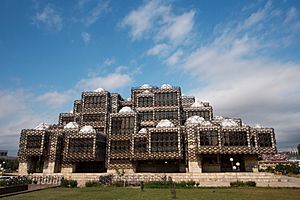
Pristina is the center of education in the country and home to many public and private primary and secondary schools, colleges, academies and universities, located in different areas across the city. The Universiteti i Prishtinës is the largest and oldest university of the city and was established in the 20th century.
Finance, arts, journalism, medicine, dentistry, pharmaceuticals, veterinary programs, and engineering are among the most popular fields for foreigners to undertake in the city. This brings a many of young students from other cities and countries to Pristina. It is known for its many educational institutions such as Universiteti i Prishtinës, Universiteti i Prishtinës Faculty of Arts and the Academy of Sciences and Arts of Kosovo.
Among the first schools known in the city were those opened during the Ottoman period. Albanians were allowed to attend these schools, most of which were religious, with only few of them being secular.
The city has numerous libraries, many of which contain vast collections of historic and cultural documents. The most important library in terms of historic document collections is the National Library of Kosovo.
Sports
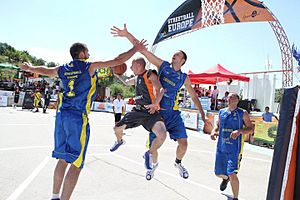
Pristina is the center of sport in Kosovo, where activity is organized across amateur and professional levels, sport organizations and clubs, regulated by the Kosovo Olympic Committee and the Ministry of Culture, Youth and Sport. Sport is organized in units called Municipal Leagues. There are seven Municipal Leagues in Pristina. The Football Municipal consists of 18 clubs, the Basketball Municipal 5 clubs, the Handball Municipal 2 clubs, Table Tennis and Chess 6 clubs each, the Karate Municipal 15 and the Tennis Municipal 2 clubs.
Football is the most popular sport in the city. It is represented by FC Prishtina, which plays their home games in the Fadil Vokrri Stadium. Basketball has been also one of the most popular sports in Pristina and is represented by KB Prishtina. It is the most successful basketball club in Kosovo and is part of the Balkan League. Joining it in the Superleague is another team from Pristina, RTV 21.
Streetball is a traditionally organised sport and cultural event at the Germia Park since 2000. Apart from indoor basketball success, Che Bar team has been crowned the champion of the national championship in 2013. This victory coincided with Streetball Kosovo's acceptance in FIBA. Handball is also very popular. Pristina's representatives are recognised internationally and play international matches.
Images for kids
-
The Monument of Brotherhood and Unity by Miodrag Živković in the city centre. "Brotherhood and unity" was a popular slogan of the Communist Party of Yugoslavia.
See also
 In Spanish: Pristina para niños
In Spanish: Pristina para niños






